New Account | Seed Mix |
Gift Certificates |AAS Winners |
Gardening Products
SEEDS: Unusual | Annuals | Perennials | Vegetables | Herbs | Trees
Our favorite Cactus Seeds from around the world
I know of no other plant that can take as much abuse and neglect as the cacti and still provide us with profuse blooms and its unique appearance. They are hardy, resilient and take up very little space. Often they will grow where no other plant will. They are truly the perfect windowsill plant. I hope my low prices will make it possible for you to enjoy these magnificent plants. I have listed a few of my favorites below.
Many thanks to our friends at Sticky Situation Cacti for the use of their photos. Please visit their site for live plants.
Also, check out our:
Succulent Plant seeds
Yucca Plant seeds
Most cacti seeds require light for germination. For maximum germination, we highly recommend using our VG07 Seedcover for tiny and pelleted seeds.

SF420 Compact Forms Mix
A mix of many types of small, ornamental compact cactus, for
use as pot plants. This mix changes often, so we do not list
species, we are constantly trying to provide the most
ornamental, compact varieties.

SF418 All Types Cacti Mix
A very diverse assortment of cacti seeds including: Cereus, Golden Barrel, Parodia, Hedgehogs, Mammillarias, Melocactus, Notocactus, Opuntias, Organ pipes, Ferocactus, Gymnocalycium, Trichocereus, Saguaro and more. This blend gives you a wide variety of shapes and sizes for a complete cacti garden.

JB093 Opuntia Species Seed Mix
This is a great collection of Prickly Pear Cacti with several different varieties of Opuntia. Opuntia engelmanii, aciculata, rufida, macrocentra, paraguayensis, phaeacantha, santa rita, basilaris and others are included in this mix.

JB199 Elephant Ear Cacti ( Opuntia ficus indica )
Often grown for cactus food for reptiles such as Tortoises and Iguanas. Also a popular cactus for human consumption. Opuntias are a major food source for Tortoises in the wild and are ideal for nearly all Tortoise species and many other reptiles such as Iguanas and other lizards. High in calcium, vitamin C and fibre. Feed whole pads to larger reptiles or cut into long strips or cubes about 1/4" wide for baby turtles and smaller replies.
Feed the cuttings directly to your reptiles or plant and grow and have a non-ending fresh supply. Plant is heat tolerant and requires little to no water. Hardy to 18°F. Tree like opuntia grows rapidly to 16' tall with heat, water and sun.
Opuntia ficus indica have no large spines. The plant is high in calcium and fiber and low in protein and fats. Has a long shelf life if refrigerated after arrival. Can last for weeks or longer properly stored.
Feed the cuttings directly to your reptiles or plant and grow and have a non-ending fresh supply. Plant is heat tolerant and requires little to no water. Hardy to 18°F. Tree like opuntia grows rapidly to 16' tall with heat, water and sun.
Opuntia ficus indica have no large spines. The plant is high in calcium and fiber and low in protein and fats. Has a long shelf life if refrigerated after arrival. Can last for weeks or longer properly stored.
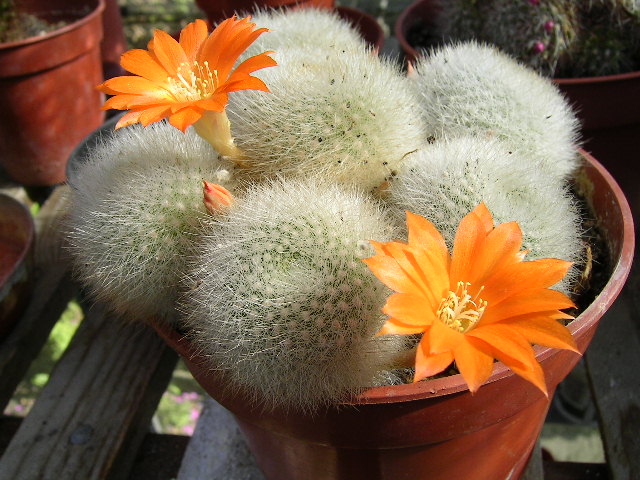
LET870 Orange Snowball ( Rebutia muscula )
Orange Snowball produces some of the most amazing flowers ever! A single plant can put out dozens in a blooming season. An easy-to-grow, easy-to-bloom plant that makes a great first cacti plant for beginners.
Rebutia muscula forms form low cushion covered by dense furry white spines and produces vibrant orange-red flower. The dense spines would protect it from the extremes of cold and sunshine. Hardy to 28 degrees.
Rebutia muscula forms form low cushion covered by dense furry white spines and produces vibrant orange-red flower. The dense spines would protect it from the extremes of cold and sunshine. Hardy to 28 degrees.

Image:Prenn, CC BY-SA 3.0, via Wikimedia Commons
JB184 White Flesh Dragon Fruit ( Hylocereus undatus )
A unique cacti with ornamental and edible appeal. The fruit is popular eaten chilled, out of hand. It is also used to flavor drinks and pastries. Unopened flowerbuds are cooked and eaten as vegetables. Easily grown in tubs in warm greenhoues in colder climates.
Hylocereus undatus is a vine-like cactus that is often grown as a night-flowering ornamental plant and as a fruit crop. The fruit is highly decorative, with a bright red skin, studded with green scales. The flesh is white, juicy and delicious in flavour, with tiny black seeds. Its exact native range is uncertain but is considered to be in Central America. Since the late twentieth century it has been widely planted on a commercial scale as a fruit crop in many tropical regions, particularly in Vietnam and other South-East Asian countries.
Hylocereus undatus is one of the most unruly species in the entire cactus family. It is a hemi-epiphyte, its fleshy, three-angled, jointed stems clamber over other plants and produce fibrous, aerial roots that cling to any available surface. In their natural habitat support is provided by trees, shrubs and rocks in the dry, open woodland of Central America and northern South America, where the species is thought to have originated. Zones 10 and higer outside, can be grown inside in cooler zones if good light provided.
Hylocereus undatus is a vine-like cactus that is often grown as a night-flowering ornamental plant and as a fruit crop. The fruit is highly decorative, with a bright red skin, studded with green scales. The flesh is white, juicy and delicious in flavour, with tiny black seeds. Its exact native range is uncertain but is considered to be in Central America. Since the late twentieth century it has been widely planted on a commercial scale as a fruit crop in many tropical regions, particularly in Vietnam and other South-East Asian countries.
Hylocereus undatus is one of the most unruly species in the entire cactus family. It is a hemi-epiphyte, its fleshy, three-angled, jointed stems clamber over other plants and produce fibrous, aerial roots that cling to any available surface. In their natural habitat support is provided by trees, shrubs and rocks in the dry, open woodland of Central America and northern South America, where the species is thought to have originated. Zones 10 and higer outside, can be grown inside in cooler zones if good light provided.
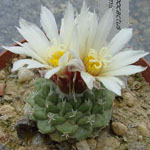
LET846 Strombocactus disciformis
Strombocactus is a monotypic genus with a strong turnip-like root, a small, depressed, roughly spherical stem covered with spirally arranged overlapping tubercles, each with a spine-bearing areole at its tip. Flowers come from new growth at the crown, and the cactus's small seeds are difficult to see with the naked eye.
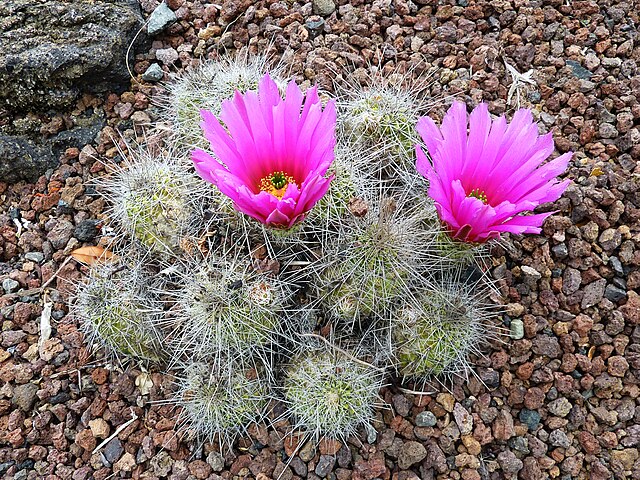
Image:James Steakley, CC BY-SA 3.0, via Wikimedia Commons
LET869 Strawberry Hedgehog Cacti ( Echinocereus stramineus )
The Strawberry Hedgehog Cacti is a cactus that can grow up to 12 inches tall and form clusters that are 2–3 feet wide. It's a good choice for desert, rock, succulent, or Mediterranean gardens, and it can also be grown in containers. The plant is drought tolerant and does best in well-drained soil in full sun. It's important to ensure the plant has excellent drainage to prevent rot.
The fruit of the Echinocereus stramineus is strawberry-flavored and can grow up to 2.5 inches in length and width. To eat the fruit, you can slice it in half and scoop out the pulp and seeds. Good container plant, can withstand down to 25 degrees outside.
The fruit of the Echinocereus stramineus is strawberry-flavored and can grow up to 2.5 inches in length and width. To eat the fruit, you can slice it in half and scoop out the pulp and seeds. Good container plant, can withstand down to 25 degrees outside.

TWT197 Espostoa nana
A wonderful columnar cacti that will grow to 5 feet or more outside, but it makes a wonderful container plant as well. Very unique with it's white hairy covering.
Full sun to light shade. Avoid hot locations. Regular water summer, keep dry winter. Origin: Peru, 3000 to 5000 feet elevation. Hardy to 25 degrees.
Full sun to light shade. Avoid hot locations. Regular water summer, keep dry winter. Origin: Peru, 3000 to 5000 feet elevation. Hardy to 25 degrees.

Image:Michael Wolf, Penig, CC BY-SA 3.0, via Wikimedia Commons
LET795 Mini Barrel Cacti ( Ferocactus macrodiscus )
Easy to grow container cacti inside, or great rock/cacti garden plant outside. Full sun to light shade. Hardy to 25 F. Water sparingly summer, keep dry winter. Solitary barrel with a bluish green stem grows to 8-12" tall. Pink and white striped flowers.

SF258 Oaxaca Cardon ( Pachycereus weberi )
Also known as candelabro, (the common name being an obvious reference to the resemblance of plants to candelabras). A giant, columnar cactus with a spreading, candelabra-like crown to 30 feet tall from central and southern Mexico, where it grows in scrubland or dry forest. In cultivation Pachycereus weberi is best suited to dry climates in USDA Zones 10 and above.
The edible, delicious fruits can be eaten raw or used to prepare jams and jellies. The seeds can be ground into a flour to make tortillas and the like.
The edible, delicious fruits can be eaten raw or used to prepare jams and jellies. The seeds can be ground into a flour to make tortillas and the like.

Image: SonoranDesertNPS from Tucson, Arizona [CC BY 2.0], via Wikimedia Commons
LET794 Fishhook Barrel Cactus ( Ferocactus wislizeni )
Bears distinctively patterned red and white spines and bears
lemon, orange or red blooms when only 12" in diameter.
Tolerates abuse and neglect well. Will eventually reach size of
10 ft. tall by 3 ft. across after many years of growth. Good
container plant for inside, it requires a warm climate if grown
outside. Will not tolerate temperatures below 41 degrees F.

SF284 Purple Prickly Pear ( Opuntia santa rita )
Native to the Sonoran desert, the purple prickly pear grows in clumps, usually to about 4 feet tall by 5 feet wide. This cactus appears much like a shrub. The large leaf pads develop a purple tinge in the cool, dry winter months. The pads are covered with large, tan spines. Flowers appear in late spring, and are yellow with red centers. The rich purple pads provide plenty of interest. During the summer, the pads are a softer blue-grey color. Bright yellow flowers, to 3 inches in diameter, produce red to purple fruit. Plant is hardy down to 10 degrees.

D9917 Yellow Pitaya, Yellow Dragon Fruit ( Hylocereus megalanthus )
This rare cactus fruit has a unique sweet flavor. The seeds are slightly larger than most dragonfruit, and the inside fruit is extremely sweet and juicy!
Yellow Dragon fruit have an oblong shape and are slightly smaller in size than the more common red varieties. Their thick yellow skin is covered in small knobby protrusions, which when immature displays small spines that will naturally fall off as the fruit matures. Beneath the skin is a dense white flesh containing numerous petite, edible black seeds. Yellow Dragon fruit has a crisp, juicy texture and very sweet, tropical flavor with floral hints and no acidity.
Yellow Dragon fruit is typically eaten raw, either straight out of the skin or scooped out and cubed, balled or sliced. For the best flavor, refrigerate the fruit for 2 hours before preparing raw. Add to tropical fruit salads or serve alone as dessert. Yellow Dragon fruit flesh can be pureed and made into a sauce or syrup or added to smoothies and cocktails. Freeze the pureed pulp for sorbet or a granitas. Use the flesh to flavor pastries or other baked goods. Yellow Dragon fruit can be kept at room temperature for a few days and will keep in the refrigerator for up to a week.
The Yellow Dragon fruit has been used for centuries by the native people of northern South America. It was used for both medicinal and culinary purposes. It has only been since the early 2000s that Yellow Dragon fruit was approved for export to North America and Europe.
It is native to the northern region of South America, what is now Colombia and Ecuador. The fruits are still cultivated there, with Colombia being the largest producer, and are exported all over the world. They are also grown in Bolivia, Peru, and Mexico and in California and Florida in the United States. Growers specializing in rare fruits in the United States, specifically in southern California and Florida, grow Yellow Dragon fruit on a smaller scale. The Yellow Dragon fruit cactus has long extending stems that can grow up to 20 feet long and require some form of trellising or support to grow on. The cactus prefers arid tropical and subtropical climates and is fairly heat resistant and somewhat cold-hardy. Yellow Dragon fruits can be spotted at most markets and specialty stores and at farmer’s markets in Southern California and Florida.
Zones 10 and higer outside, can be grown inside in cooler zones if good light provided.
Yellow Dragon fruit have an oblong shape and are slightly smaller in size than the more common red varieties. Their thick yellow skin is covered in small knobby protrusions, which when immature displays small spines that will naturally fall off as the fruit matures. Beneath the skin is a dense white flesh containing numerous petite, edible black seeds. Yellow Dragon fruit has a crisp, juicy texture and very sweet, tropical flavor with floral hints and no acidity.
Yellow Dragon fruit is typically eaten raw, either straight out of the skin or scooped out and cubed, balled or sliced. For the best flavor, refrigerate the fruit for 2 hours before preparing raw. Add to tropical fruit salads or serve alone as dessert. Yellow Dragon fruit flesh can be pureed and made into a sauce or syrup or added to smoothies and cocktails. Freeze the pureed pulp for sorbet or a granitas. Use the flesh to flavor pastries or other baked goods. Yellow Dragon fruit can be kept at room temperature for a few days and will keep in the refrigerator for up to a week.
The Yellow Dragon fruit has been used for centuries by the native people of northern South America. It was used for both medicinal and culinary purposes. It has only been since the early 2000s that Yellow Dragon fruit was approved for export to North America and Europe.
It is native to the northern region of South America, what is now Colombia and Ecuador. The fruits are still cultivated there, with Colombia being the largest producer, and are exported all over the world. They are also grown in Bolivia, Peru, and Mexico and in California and Florida in the United States. Growers specializing in rare fruits in the United States, specifically in southern California and Florida, grow Yellow Dragon fruit on a smaller scale. The Yellow Dragon fruit cactus has long extending stems that can grow up to 20 feet long and require some form of trellising or support to grow on. The cactus prefers arid tropical and subtropical climates and is fairly heat resistant and somewhat cold-hardy. Yellow Dragon fruits can be spotted at most markets and specialty stores and at farmer’s markets in Southern California and Florida.
Zones 10 and higer outside, can be grown inside in cooler zones if good light provided.
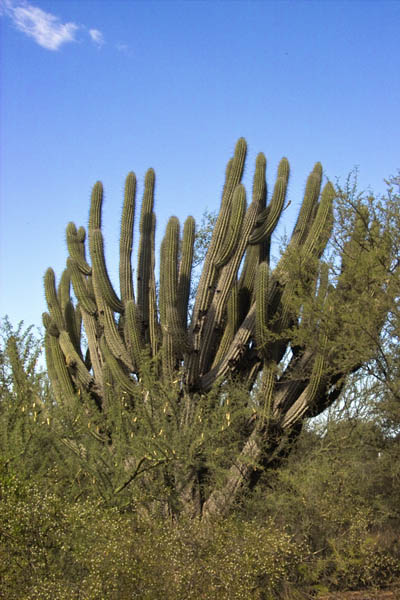
Image:AstroKaktus, CC BY-SA 3.0, via Wikimedia Commons
LET847 Toothpick Cacti ( Stetsonia coryne )
Stetsonia coryne, the toothpick cactus, is the sole species in the cactus genus Stetsonia. Stetsonia coryne grows to a height of 15 to 25 feet tall. It has white flowers. This cacti, also contains Mescaline ( and other alkaloids ).
The plant is large, arborescent habit , tree-like reaches a growth height of 5 to 8 meters up to 12 meters. The trunk is thick and short, measuring about 4 dm in diameter, with numerous erect or somewhat bent branches form from a trunk. The blue-green shoots, turn greenish-gray with age, usually not jointed and have a diameter of 9 to 10 centimeters. There are 8 to 9 blunt-edged, somewhat notched ribs that are 1 to 1.5 centimeters high. The yellow spines, which later turn black, are straight and stiff.
The central spine grows to 2–5 cm long and are thickened at the base., the 7 to 9 spreading marginal spines to 3 centimeters long. There is a single central spine, straight and more robust, which can measure up to 8 cm in length. All are black or yellowish-brown in color, although they eventually turn white with a dark tip.
Hardy to 18 degrees. It flowers from October to April with funnel-shaped flowers that are white and grow up to 15 centimeters in diameter. They open at night and often remain open until the next day. The pericarp is covered with numerous, roof-tile-like, the long corolla tube with scattered scales.
The plant is large, arborescent habit , tree-like reaches a growth height of 5 to 8 meters up to 12 meters. The trunk is thick and short, measuring about 4 dm in diameter, with numerous erect or somewhat bent branches form from a trunk. The blue-green shoots, turn greenish-gray with age, usually not jointed and have a diameter of 9 to 10 centimeters. There are 8 to 9 blunt-edged, somewhat notched ribs that are 1 to 1.5 centimeters high. The yellow spines, which later turn black, are straight and stiff.
The central spine grows to 2–5 cm long and are thickened at the base., the 7 to 9 spreading marginal spines to 3 centimeters long. There is a single central spine, straight and more robust, which can measure up to 8 cm in length. All are black or yellowish-brown in color, although they eventually turn white with a dark tip.
Hardy to 18 degrees. It flowers from October to April with funnel-shaped flowers that are white and grow up to 15 centimeters in diameter. They open at night and often remain open until the next day. The pericarp is covered with numerous, roof-tile-like, the long corolla tube with scattered scales.

JB219 Mojave Mound Cactus ( Echinocereus polyacanthus )
Solitary or clumping, forming large colonies, each stem up to 12 inches tall. Red or orange flowers with lighter center. Origin: Arizona, New Mexico, northwestern Mexico.
Hardy to 15°F. Full sun, needs little water and good drainage.
Hardy to 15°F. Full sun, needs little water and good drainage.
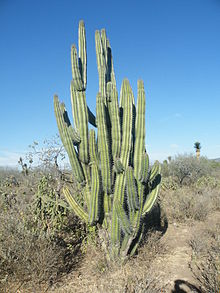
LET848 Gray Ghost Organ Pipe ( Stenocereus pruinosus )
This frost tender cactus is a popular potted plant indoors and out provided the potting soil is sufficiently porous and well drained.
This large columnar cactus is a valuable food source in Mexico where its fruit is harvested and sold in some rural markets. It is native to south central Mexico as far north as Puebla and south to Oaxaca, with plants are also found in the drier parts of Veracruz to the east. This is a tree like columnar cactus that may produce one or more trunks from which little-branching stems arise from the base for a distinctive V-shape. Each stem is gray green, the new growth often bearing a distinctive bloom. This led to its unusual common name, gray ghost organ pipe. Full sun. Heat tolerant. Little to moderate water. Hardy to 23°F. Fast growing to 20' tall. Origin: South-central Mexico.
This large columnar cactus is a valuable food source in Mexico where its fruit is harvested and sold in some rural markets. It is native to south central Mexico as far north as Puebla and south to Oaxaca, with plants are also found in the drier parts of Veracruz to the east. This is a tree like columnar cactus that may produce one or more trunks from which little-branching stems arise from the base for a distinctive V-shape. Each stem is gray green, the new growth often bearing a distinctive bloom. This led to its unusual common name, gray ghost organ pipe. Full sun. Heat tolerant. Little to moderate water. Hardy to 23°F. Fast growing to 20' tall. Origin: South-central Mexico.
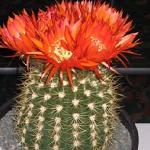
LET849 Stenocereus pruinosus
An easy to grow cacti that is great for containers when young. Little to moderate water. Hardy to 23°F. Fast growing to 20' tall outside in warm climates. Origin: Plants are found growing in Argentina in Catamarca, Jujuy, La Rioja, Mendoza, Salta, and San Juan.
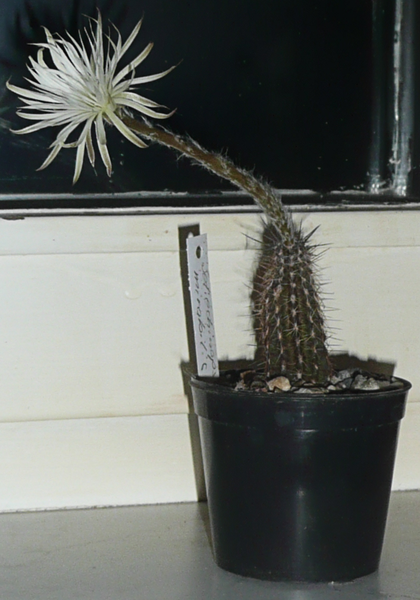
Image:Faolán, CC BY-SA 3.0, via Wikimedia Commons
LET850 Setiechinopsis mirabilis
A unique cacti that is easily grown from seeds, but have an unusually short life span for cacti, only lasting a few years. The flowers are nocturnal, lasting for only one night, but a number are produced in succession, they like to bloom.
Best raised in six inch pots, a good inside plant. It is a small, yet stunning cacti best known for its large and fragrant flowers. In addition to that, it is self-fertile—meaning that the plant will self-pollinate without assistance or a second flower, leading to the production of many seeds each year.
Best raised in six inch pots, a good inside plant. It is a small, yet stunning cacti best known for its large and fragrant flowers. In addition to that, it is self-fertile—meaning that the plant will self-pollinate without assistance or a second flower, leading to the production of many seeds each year.
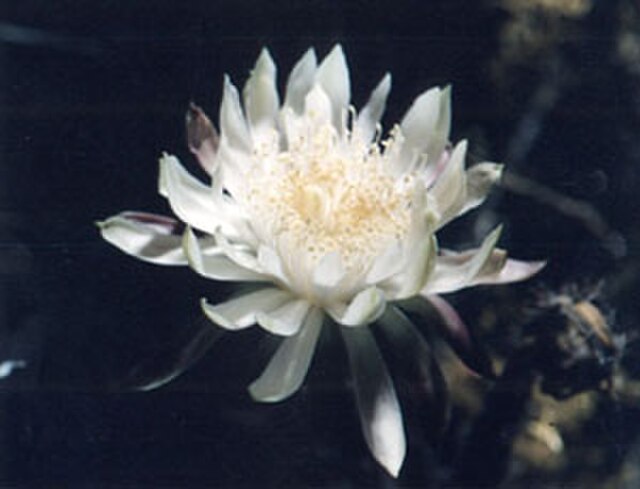
LET852 Peniocereus greggii v. transmontanus
Light shade to full sun. Heat resistant. Little water required. Hardy to 20°F. Grayish green trailing stems reaching 10 or more feet, often growing into trees. Strongly scented white flowers. USDA: 9-10.

JB247 Echinopsis subdenudata
Echinopsis subdenudata is a globular, almost spineless or with very short cream spines that produces splendid night-blooming, white funnel shaped, fragrant flowers up to 9 inches long. Hardy to 32 degrees. Water sparingly, provide good drainage.
Zones 9 and abover outside, but great container plant for inside.
Zones 9 and abover outside, but great container plant for inside.

JB217 Monstrose Apple Cactus ( Cereus peruvianus monstrosus )
Cereus peruvianus monstrosus is an incredibly unique specimen that grows taller than most any other succulent in a columnar form. As it grows more mature, it blooms (rarely) small white flowers that give way to orange to red fruit that look similar to an apple. Flowers only open at night however, and live for less than 24 hours before closing. Because of its extensive taproot system and relatively no need for regular watering, Monstrose apple cactus can be planted in areas with little to no irrigation such as in desert style landscapes, medians and hot, arid climates. Plant in full sun and well draining soil to avoid root rot. Mealybugs and scale are only minor pest issues for this wonderfully low-maintenance plant. For zones 9-11 outside, or easily grown in containers.

LET574 Tree Cholla ( Cylindropuntia imbricata )
This is a tree-like cactus with a short, woody trunk and a number of upright candalabra-like branches. A mature trunk will have a 4 inch or larger diameter and the plant can reach 8-10 feet tall, in some cases taller.
The spiny stems are jointed and cylindrical. Large, showy flowers open out wide and are reddish-purple in color. Fruits ripen from green to rose to yellow.
Considered invasive in places in the SouthWest as the joints that fall to the ground regenerate new plants quickly. It can take severe drought and hard freezes and is suitable to USDA Zones 6 and above.
The spiny stems are jointed and cylindrical. Large, showy flowers open out wide and are reddish-purple in color. Fruits ripen from green to rose to yellow.
Considered invasive in places in the SouthWest as the joints that fall to the ground regenerate new plants quickly. It can take severe drought and hard freezes and is suitable to USDA Zones 6 and above.

LET575 Cereus forbesii
Cereus forbesii is a species of columnar cactus whose native range is Bolivia to N. Central Argentina. The species is a branched, shrubby cactus that can grow up to 23 feet tall in height, but is usually found at a height of 6-7 feet tall. It grows in arid hills, forests, plains, and on the edges of salt flats.
USDA: 9b-11. Hardy to 32° F, protect friom frost. Full sun. Columnar, branching growth to 14' tall, 5" in diameter. Moderate water summer, light water in winter. White nocturnal flowers, up to 3 inches long. Origin: Eastern Bolivia, Argentina. Good container plant, start with small containers and step up in size every couple of years.

JB259 Peruvian Tree Cactus ( Armatocereus laetus )
A stunning, robust, treelike cactus to 20 feet tall with a candelabra-like crown of thick, ridged, bluish gray branches. The white flowers are followed by small, spiny, green fruits. Native to southern Ecuador and Peru, where it grows in dry valleys of the Andes in scrublands on rocky slopes. In cultivation it is best suited to drier warm temperate climates in USDA Zones 9 to 11. Regular water summer, little water in winter. 4" long, white nocturnal flowers. Origin: Northern Peru.

LET578 Acanthocalycium violaceum
USDA: 8-10. Frost hardy to 25°F. Solitary to clumping growth, up to 2' tall, 6" diameter. Regular water summer; winter keep dry. Full sun to light shade. white to violet flowers. Origin: Banos de Zapallar /San Luis Argentina.

LET577 Argentina Tree Cacti ( Armatocereus procerus )
A tree type cacti with great ornamental appeal. Solitary to clumping growth, up to 20' tall, 6" diameter. Regular water summer; winter keep dry. Full sun to light shade. white to violet flowers. Origin: Banos de Zapallar /San Luis Argentina. USDA: 8-10. Frost hardy to 25°F.

TWT180 Mammillaria columbiana
A very nice container cacti for windowsills and tables. Clumping, globular cactus to 6" tall. Bright red pink flowers spring and summer. Light shade. Hardy to 32 degrees. Water sparingly, provide good drainage.

JB193 Echinocereus scheeri
An easy to care for cacti that does very well in pots. Full sun, needs little water and good drainage. Forms clumbs of yellowish green stems to 28" tall. Pink flowers will last up to a week, opening at night and may close during the hot part of day. Origin: Mexico. Zones 7-10 outside, good container plant. Hardy to 25 degrees.
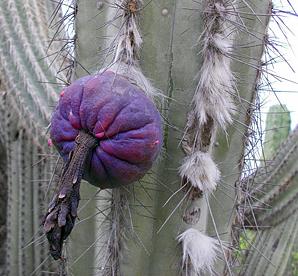
SF401 Pilosocereus chrysacanthus
A robust, tree-like cactus to about 15 feet tall with a much branched, candelabra-like crown of fairly slender, succulent, deeply ribbed, bluish green shoots to about 3 inches in diameter.
The edible fruits have deep purple flesh. Pilosocereus chrysacanthus is native to dry regions in southern Mexico in the states of Guerrero, Puebla and Oaxaca and adapts well to cultivation in warm temperate and dry tropical climates in USDA Zones 10 and above.
The edible fruits have deep purple flesh. Pilosocereus chrysacanthus is native to dry regions in southern Mexico in the states of Guerrero, Puebla and Oaxaca and adapts well to cultivation in warm temperate and dry tropical climates in USDA Zones 10 and above.
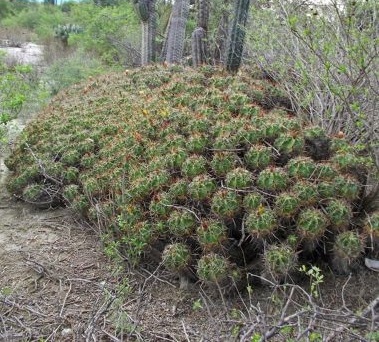
LET368 Clustering Barrel Cactus ( Ferocactus robustus )
This cushion-forming cactus is native to the Mexican States of Puebla and Veracruz and forms a large mound that can reach a diameter of as much as 15 feet across, with sometimes hundreds of thick, ridged shoots to 2-3 feet tall, densely armed with reddish spines. A magnificent, very drought tolerant and fairly cold hardy cactus, suitable for dry temperate areas in USDA Zones 9 and above.
This is a most unique cacti to have in your collection.
This is a most unique cacti to have in your collection.

SF251 Queen of the Night ( Selenicereus Grandiflorus )
A gorgeous night blooming cactus with large white flowers that grow to several inches. The flowers are also fragrant, with a mild vanilla-like scent. Bears spiny, 2-4" long red ripening fruits that are edible and fairly tasty, with much similarity to the dragon fruit. There are numerous subspecies and crosses of this species.
An easy care, fast growing cactus, with a clambering habit, also excellent if used in a hanging basket.
Primarily grown as a container cacti indoors, it is hardy to zone 10a (30 - 35F) outside.
An easy care, fast growing cactus, with a clambering habit, also excellent if used in a hanging basket.
Primarily grown as a container cacti indoors, it is hardy to zone 10a (30 - 35F) outside.

Image: Andrey Zharkikh from Salt Lake City, USA, CC BY 2.0, via Wikimedia Commons
SF342 Mexican Claret Cup ( Echinocereus coccineus )
Clumping growth habit to 16" tall. Often becomes a large colony. An outstanding species that blooms in mid-spring with a profusion of hummingbird-attracting orange to scarlet-red flowers held over a mound of tight clustering stems. Flowers attract bees and hummingbirds. For zones 4-9.

SF346 Ecuadorian Tree Cactus ( Armatocereus godingianus )
Tropical cactus, keep from frost. Full sun to part shade. Columnar tree cactus, up to 30' tall outside, but a very nice container cacti while young. Regular water summer, little water in winter. Large (up to 4" long) white nocturnal flowers. Origin: Ecuador. Hardy to 35° F.

JB173 San Pedro Cacti ( Trichocereus pachanoi )
A dark green columnar cacti that can reach 10-20 ft. tall. Bears showy white fragrant flowers at night that can reach 9" across. Cold hardy outside to 15 degrees when mature. Good cacti for beginners.
Evidence suggests San Pedro was cultivated as early as 200 to 600 BC and selected for its psychoactive effects High altitude adaptation means it can survive at -10°F, while easily propagated foot-long sections placed in the soil can develop roots in a few weeks. Once established, San Pedro can happily grow about a foot per year.
Evidence suggests San Pedro was cultivated as early as 200 to 600 BC and selected for its psychoactive effects High altitude adaptation means it can survive at -10°F, while easily propagated foot-long sections placed in the soil can develop roots in a few weeks. Once established, San Pedro can happily grow about a foot per year.

Image:Walterswithin, CC BY-SA 4.0, via Wikimedia Commons
LET842 Huancabamba Peruvian Torch ( Trichocereus peruvianus Huancabamba )
Discover the rich history and cultural significance of Trichocereus peruvianus var. Huancabamba or the Huancabamba Peruvian Torch Cactus. Found high in the Andean mountain deserts of Peru and Ecuador, this cactus has been used by the monks of a pre-Inca culture known as Chavín in their ritualistic ceremonies to diagnose spiritual links to a patient's illness. Its active compound, mescaline, has been reported to be present in a concentration of 1.2% in the dried cactus, and it also contains varying phenethylamines and other substances in minimal proportions. Today, Curanderos or medicine men of northern Peru still use it for spiritual and medicinal purposes. A close relative of the San Pedro cactus.

TWT185 Trichocereus Hybrids Mix
Seeds are collected from plants with all colors of the rainbow, from red, orange, yellow, apriocot, magenta, pink, ect.

3723 King Cup Cacti ( Echinocereus triglochidiatus )
One of the most attractive hedgehog cacti is the King Cup, which grows in clumps as much as 3-4 feet across but usually smaller. The bright red-orange flowers often cover the whole plant, which is cylindrical and low-growing, often hugging up against some larger plant.
The numerous flowers grow at the top of the stems, all about the same height, giving a full view of all the flowers at one glance. They last for several days. The flowers vary slightly in color as a result of soil type or genetic differences. Zones 7-10. Hardy to 20°F and lower. Full sun to light shade in hotter desert gardens. Needs little water and good drainage.
The numerous flowers grow at the top of the stems, all about the same height, giving a full view of all the flowers at one glance. They last for several days. The flowers vary slightly in color as a result of soil type or genetic differences. Zones 7-10. Hardy to 20°F and lower. Full sun to light shade in hotter desert gardens. Needs little water and good drainage.

SF318 Melocactus neryi
A small solitary cacti that does very well in small clay pots. Easy to care for, fuss free and unique look. Cold hardy to about 30 degrees.

3688 Notocactus magnificus
A picture perfect cacti for pots or patio. Prefers light shade or a small amount of full sun. Regular water in summer, keep dry in winter, root rot prone. Origin: Brazil. Zones 9b-11.

LET303 Notocactus grossei
(Syn: ERIOCACTUS grossei) USDA: 9b-11. Light shade. Hardy to 32° F. Full sun. Regular water in summer, keep dry in winter. Solitary or clumping, globular to columnar growth to 12" diameter. Yellow flowers. Origin: Paraguay.

SF417 Giant Barrel Cacti ( Echinocactus platyacanthus )
The largest of all barrel cacti is native to the deserts of northeastern and central Mexico and can reach a height of up to 15 feet, with a diameter of 4 feet or more. It grows relatively slowly and forms a deeply ribbed, dark green stem armed with short brown spines. It does best in dry, warm temperate climates in USDA Zones 10 to 11 and should be kept as dry as possible during winter.

Image:Stan Shebs, CC BY-SA 3.0, via Wikimedia Commons
D8433 Barrel ( ferocactus )
A good selection for inside or outside. The plant assumes a
columnar barrel type shape and can grow up to 3' outside. It is
a heavy bloomer with large flowers. Very stout spines with a
hooded central spine.

SF380 Blue Barrel ( Ferocactus glaucescens )
An excellent indoor pottted cacti. A smallish cactus that forms a usually solitary, bluish green, deeply ridged, robust and thick stem to about 20 inches tall and almost 20 inches wide, giving it a barrel look when mature. It is fiercely armed with small clusters of showy, broad, yellowish spines and has yellow flowers.
It is native to dry juniper woodlands in central Mexico. It is a robust and easy to grow cactus for desert regions and also makes a very attractive potted plant.
The flower is lemon yellow, funnel-shaped and up to 1.6 inches in diameter.
Zone 9b and higher outside, widely grown inside.
It is native to dry juniper woodlands in central Mexico. It is a robust and easy to grow cactus for desert regions and also makes a very attractive potted plant.
The flower is lemon yellow, funnel-shaped and up to 1.6 inches in diameter.
Zone 9b and higher outside, widely grown inside.

SF395 Mexican Lime Barrel ( Ferocactus pilosus )
A stunning barrel cactus, up to 8 feet tall, endemic to the northern and central desert regions of Mexico, with dense reddish spines and beautiful yellow to red flowers.
Traditionally, the flower buds of Ferocactus pilosus are harvested and eaten by the indigenous population. Will thrive in hot, dry climates and will tolerate mild frost once established.
Traditionally, the flower buds of Ferocactus pilosus are harvested and eaten by the indigenous population. Will thrive in hot, dry climates and will tolerate mild frost once established.

IP359 Lady Fingers Cacti ( Echinocereus pentalophus )
Lady Fingers is one of the most beautiful flowering cacti and once mature, the plant is loaded with blooms. The stems root as they creep, and some clones are stoloniferous. They are easy to grow inside in wide, shallow pots or flats. Stems that grow beyond the pot will hang down for two feet or more and be covered with blooms during flowering stage.
Should not be grown in full sun, actually prefers about 30 percent shade, making for a good patio plant. Easy to grow in pots, zone 9 and higher outside.
Should not be grown in full sun, actually prefers about 30 percent shade, making for a good patio plant. Easy to grow in pots, zone 9 and higher outside.

Image: Raffi Kojian, CC BY-SA 3.0, via Wikimedia Commons
JB237 Silver Torch Cacti ( Cleistocactus strausii )
A fast growing branching columnar cacti from South America that
is covered with eye-catching silvery spines when older. Starts
out solitary when young, but branches out and creates it's own
clumps as it matures. Can grow to 6 ft. tall. Good container
plant for inside, it requires a warm climate if grown outside.
Will not tolerate temperatures below 41 degrees F.

LET103 Cleistocactus morawetzianus
A shrubby, columnar cactus with slender, erect stems that are branching from the base and growing to about 8 feet tall if grown outside, modertely armed with grayish spines. The tubular flowers are white. Cleistocactus morawetzianus is native to dry, interandean valleys in central an southern Peru. It is easy to grow in most warm temperate climates. It makes a great container plant for cooler zones, should be protected from freezing.

JB250 Beavertail Prickly Pear ( Opuntia basilaris )
Widespread in deserts throughout the southwestern USA, this attractive cactus forms dense clusters of large, bluish pads that rarely have spines. The flowers are brilliant purple-pink. It is hardy to USDA Zone 8 and need excellent drainage in more humid regions.
Makes a nice container plant and will live many years in a pot provided it is not overwatered. The Beavertail Cactus is a medium-sized to small prickly pear cactus, depending on variety, growing to about 24 inches tall. A single plant may consist of hundreds of fleshy, flattened pads. These are more or less blue-gray, depending on variety, growing to a length of 6 inches and are maximum 4 inches wide and about 1/2 inch thick. They are typically spineless, but have instead many small barbed bristles, called glochids, that easily penetrate the skin.
Makes a nice container plant and will live many years in a pot provided it is not overwatered. The Beavertail Cactus is a medium-sized to small prickly pear cactus, depending on variety, growing to about 24 inches tall. A single plant may consist of hundreds of fleshy, flattened pads. These are more or less blue-gray, depending on variety, growing to a length of 6 inches and are maximum 4 inches wide and about 1/2 inch thick. They are typically spineless, but have instead many small barbed bristles, called glochids, that easily penetrate the skin.
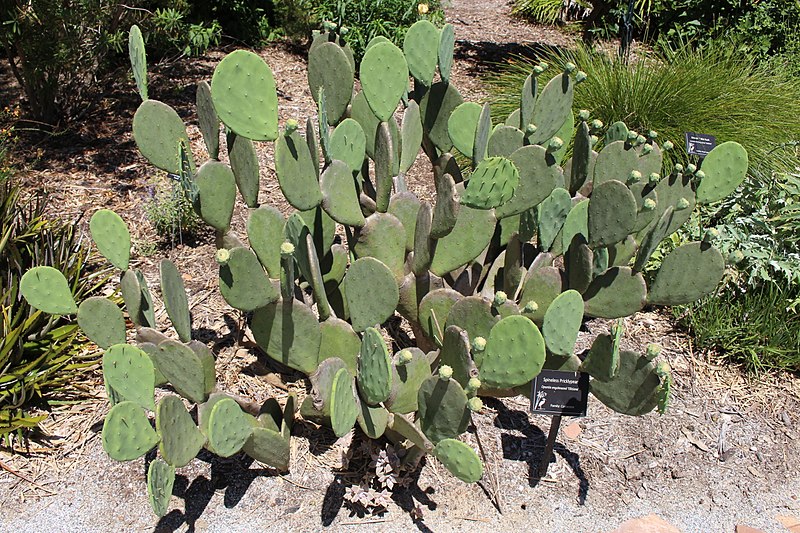
Image:Michael Rivera, CC BY-SA 4.0, via Wikimedia Commons
LET854 Spineless Prickly Pear ( Opuntia ellisiana )
A great pad cacti without spines! It is also extremely heat tolerant, and its low spreading nature makes it an ideal choice for roadways plantings and even green roofs. During the summer months it sports large, bright yellow blossoms that provide nectar for hummingbirds.
These are followed by attractive and edible bright red fruits. Spineless, with few glocids. Full sun. Heat tolerant. Little water. Hardy to 16°F. Slow growing to 2' tall; 8' wide. Origin: Mexico, Texas.
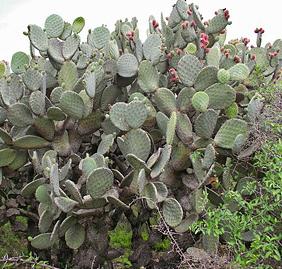
LET855 Giant Prickly Pear ( Opuntia streptacantha )
A large cactus, native to eastern and central Mexico between 1900 and 2800 m. It forms a shrub or small tree to 12 feet tall with a robust trunk and a much branched crown of large, flattened, spiny shoots. Flowers are yellow to orange. Like other Opuntia it is easily grown and hardy to severe drought and moderate freezes.

Image: Chris English [CC BY-SA 3.0], via Wikimedia Commons
D8422 Giant Saguaro ( Carnegeia gigantea )
Also known as Suhaurao. If you want a cacti that will outlive you and may reach a
height of 30 ft. or more, then this one is for you. Its the familiar cacti shown in western film. Has a solitary trunk and outstretched limbs that resembles arms. Makes a nice container plant when young.

IP290 Bishops Cap ( Astrophytum myriostigma )
A. myriostigma is a spineless cactus defined by the presence of three to seven (usually five) pronounced vertical ribs which define the cactus' shape when young. Very easy to grow and care free, it is commonly grown as an ornamental plant in cactus collections.

D8497 Peruvian Torch Cacti ( Trichocereus pervianus )
Stout 6-12 ft. columnar cacti with bluish-green color. An easy to grow,
fast growing cacti that features large 10" sweet scented flowers that bloom
at night. Cold hardy to 25 degrees when mature.

Image:Imartin6, CC BY 3.0 , via Wikimedia Commons
LET733 Elephant Cactus ( Pachycereus pringlei )
Pachycereus pringlei (also known as Mexican giant cardon or elephant cactus) is a species of large cactus native to northwestern Mexico, in the states of Baja California, Baja California Sur, and Sonora. It is commonly known as cardón, a name derived from the Spanish word cardo, meaning "thistle"; additionally, it is often referred to as sabueso (or "bloodhound"), which is possibly an early Spanish interpretation of the native Seri term for the plant.
Large stands of this cactus still exist, but many have been destroyed as land has been cleared for cultivation in Sonora. The cactus fruits were always an important food for the Seri people, in Sonora; the dried cactus columns themselves could be used for construction purposes, as well as for firewood.
A symbiotic relationship with bacterial and fungal colonies, on its roots, allows P. pringlei to grow on bare rock, even where no soil is available at all; the cactus has the distinction of being lithophytic as needed. The root’s bacterial colonies can fix nitrogen from the air and break down the rock to expose hidden sources of nutrients. The cactus even evolved to maintain this symbiotic bacteria within its seeds, serving to benefit by taking it on as part of its very physical biology.
Morphology A cardon specimen is the tallest living cactus in the world, with a maximum recorded height of 63 feet with a stout trunk up to 3 ft 3 inches in diameter bearing several erect branches. In overall appearance, it resembles the related saguaro (Carnegiea gigantea), but differs in being more heavily branched and having branching nearer the base of the stem, fewer ribs on the stems, blossoms located lower along the stem, differences in areoles and spination, and spinier fruit.
Its flowers are white, large, nocturnal, and appear along the ribs as opposed to only apices of the stems. An average mature cardon may reach a height of 30 feet, but individuals as tall as 60 feet are known. It is a slow-growing plant with a lifespan measured in hundreds of years. Most adult cardon have several side branches that may be as massive as the trunk. The resulting tree may attain a weight of 25 tons.
Large stands of this cactus still exist, but many have been destroyed as land has been cleared for cultivation in Sonora. The cactus fruits were always an important food for the Seri people, in Sonora; the dried cactus columns themselves could be used for construction purposes, as well as for firewood.
A symbiotic relationship with bacterial and fungal colonies, on its roots, allows P. pringlei to grow on bare rock, even where no soil is available at all; the cactus has the distinction of being lithophytic as needed. The root’s bacterial colonies can fix nitrogen from the air and break down the rock to expose hidden sources of nutrients. The cactus even evolved to maintain this symbiotic bacteria within its seeds, serving to benefit by taking it on as part of its very physical biology.
Morphology A cardon specimen is the tallest living cactus in the world, with a maximum recorded height of 63 feet with a stout trunk up to 3 ft 3 inches in diameter bearing several erect branches. In overall appearance, it resembles the related saguaro (Carnegiea gigantea), but differs in being more heavily branched and having branching nearer the base of the stem, fewer ribs on the stems, blossoms located lower along the stem, differences in areoles and spination, and spinier fruit.
Its flowers are white, large, nocturnal, and appear along the ribs as opposed to only apices of the stems. An average mature cardon may reach a height of 30 feet, but individuals as tall as 60 feet are known. It is a slow-growing plant with a lifespan measured in hundreds of years. Most adult cardon have several side branches that may be as massive as the trunk. The resulting tree may attain a weight of 25 tons.

Image: Davepape, Public domain, via Wikimedia Commons
LET734 Argentine Toothpick ( Stetsonia coryne )
Stetsonia coryne grows to a height of 15 to 25 feet tall. It has white flowers. The genus was named to honor Francis Lynde Stetson, a New York attorney and plant lover.
The plant is large, arborescent habit , tree-like reaches a growth height of 15-20 feet up to 35 feet. The trunk is thick and short, with numerous erect or somewhat bent branches form from a trunk. The blue-green shoots, turn greenish-gray with age, usually not jointed and have a diameter of 9 to 10 centimeters. There are 8 to 9 blunt-edged, somewhat notched ribs that are 1 to 1.5 centimeters high. The yellow spines, which later turn black, are straight and stiff. The central spine grows to 2-5 cm long and are thickened at the base., the 7 to 9 spreading marginal spines to 3 centimeters long. There is a single central spine, straight and more robust, which can measure up to 8 cm in length. All are black or yellowish-brown in color, although they eventually turn white with a dark tip.
It flowers from October to April with funnel-shaped flowers that are white and grow up to 15 centimeters in diameter. They open at night and often remain open until the next day. The pericarp is covered with numerous, roof-tile-like, the long corolla tube with scattered scales.
The plant fruits from January to May and its fruit is a fleshy berry 4 cm in diameter ovoid, scaled, edible fruits are green to reddish and have a drooping floral remnant. The broadly oval, shiny blackish-brown seeds are 1.7 millimeters long and 1 millimeter wide. They are humped with a fine wrinkled pattern.
Full sun. Heat tolerant. Little to moderate water, summer. Hardy to 18 F. Branching cactus to 20 feet tall. Origin: Low deserts of Argentina, Bolivia. USDA: 9-11. Good container cacti for many years.
The plant is large, arborescent habit , tree-like reaches a growth height of 15-20 feet up to 35 feet. The trunk is thick and short, with numerous erect or somewhat bent branches form from a trunk. The blue-green shoots, turn greenish-gray with age, usually not jointed and have a diameter of 9 to 10 centimeters. There are 8 to 9 blunt-edged, somewhat notched ribs that are 1 to 1.5 centimeters high. The yellow spines, which later turn black, are straight and stiff. The central spine grows to 2-5 cm long and are thickened at the base., the 7 to 9 spreading marginal spines to 3 centimeters long. There is a single central spine, straight and more robust, which can measure up to 8 cm in length. All are black or yellowish-brown in color, although they eventually turn white with a dark tip.
It flowers from October to April with funnel-shaped flowers that are white and grow up to 15 centimeters in diameter. They open at night and often remain open until the next day. The pericarp is covered with numerous, roof-tile-like, the long corolla tube with scattered scales.
The plant fruits from January to May and its fruit is a fleshy berry 4 cm in diameter ovoid, scaled, edible fruits are green to reddish and have a drooping floral remnant. The broadly oval, shiny blackish-brown seeds are 1.7 millimeters long and 1 millimeter wide. They are humped with a fine wrinkled pattern.
Full sun. Heat tolerant. Little to moderate water, summer. Hardy to 18 F. Branching cactus to 20 feet tall. Origin: Low deserts of Argentina, Bolivia. USDA: 9-11. Good container cacti for many years.

Image:cultivar413, CC BY 2.0 , via Wikimedia Commons
LET735 Octopus Cactus ( Stenocereus alamosensis )
Stenocereus alamosensis consists of many slender, arching stems branched at the base of the cactus that often form an impenetrable thickets that reach up to 30 feet wide. These green, fleshy stems measure about four inches in diameter, and have five to eight spines with either gray or white radial spines running the entire length of the stem. Throughout the spring, the octopus cactus blooms scarlet tubular flowers.
The young plant is a tangle of prostrate, slender stems that root profusely on the lower side. The octopus cactus requires no additional water, as it thrives off of rain fall. It is considered a hardy plant, but S. alamosensis is frost-tender and needs protection in such conditions. For the best growth, the octopus cactus must live in full sun exposure.
USDA: 9b-10. Full sun. Little water. Hardy to 28°F. Thicket of bending stems, up to 10 ft tall. Tubular pinkish red flowers, attracts hummingbirds. Origin: Mexico (Chihuahua and Sonora)
The young plant is a tangle of prostrate, slender stems that root profusely on the lower side. The octopus cactus requires no additional water, as it thrives off of rain fall. It is considered a hardy plant, but S. alamosensis is frost-tender and needs protection in such conditions. For the best growth, the octopus cactus must live in full sun exposure.
USDA: 9b-10. Full sun. Little water. Hardy to 28°F. Thicket of bending stems, up to 10 ft tall. Tubular pinkish red flowers, attracts hummingbirds. Origin: Mexico (Chihuahua and Sonora)

IP286 Blue Candle ( Myrtillocactus geometrizans )
Grows to 12' tall outside, or will remain small in containers, branching; 8" diameter. Edible purple berries. For zones 9b-11 outside. Full sun. Heat tolerant. Moderate water. Origin: Northern central Mexico.

SF148 Texas Prickly Pear ( Opuntia engelmanni )
A shrubby cactus that can reach to about 3 feet tall with much branched, flat, grayish or pale green shoots and yellow flowers, native to the southwestern USA and northern Mexico at higher elevations.
It can take severe drought and hard freezes and is suitable to USDA Zones 6 and above. The fruits are edible and popular for making jelly and jam.
Good container cacti.
It can take severe drought and hard freezes and is suitable to USDA Zones 6 and above. The fruits are edible and popular for making jelly and jam.
Good container cacti.

D8418 Golden Barrel ( echinocactus )
A striking plant from Mexico Spherical when young becoming
elongegated with age. The green body is covered with heavy
gold-yellow spines. The flowers are a striking color of deep
gold.

3307 Old Man of the Andes ( Oreocereus )
This is a large cacti that can be used as a centerpiece or as a patio plant. It is a stout, upright cactus that covers itself with attractive, long, white woolly hairs. This also makes a great rock garden plant. Will normally stay small in containers, they can reach up to 10 feet tall outside after many years.
Jim's Note: Oreocereus need a minimum temperature of 45° F. Grow them in rich, porous, sandy soil and let their soil dry out between waterings. Repot in the spring, when their roots become cramped. Generally, they should be repotted every other year in order to provide fresh soil. However, this doesn't necessarily mean they'll need larger pots. Fill about a quarter of the pot with broken crocks, gravel, etc. to promote good drainage. Firm the potting soil. After repotting, do not water for a week or more.
Jim's Note: Oreocereus need a minimum temperature of 45° F. Grow them in rich, porous, sandy soil and let their soil dry out between waterings. Repot in the spring, when their roots become cramped. Generally, they should be repotted every other year in order to provide fresh soil. However, this doesn't necessarily mean they'll need larger pots. Fill about a quarter of the pot with broken crocks, gravel, etc. to promote good drainage. Firm the potting soil. After repotting, do not water for a week or more.

D8430 Hedgehog ( echinocereus )
A must for every collection. Small and globular in shape and covered with short curving spines. Flowers profusely, flowers vary in color. It is a very tolerant plant and is a good selection for beginners. Great in small pots and containers.

FB102 Melocactus
Similar to barrel cacti when young but from their crown a large tuft of bristles will emerge. Produces small pink flowers and edible fruits. Excellent inside plant.
PLANTING YOUR SEEDS
With a little patience and effort, you should have no problem raising beautiful cacti from the seeds you receive from us. Please remember that the seeds will sprout over a period of time, so don't be disappointed when only a few first start to sprout. The others will arrive given time. Usually most of the seeds will sprout between 3-10 weeks.Bottom heat will give faster results, but is not an absolute necessity. If you can provide bottom heat, then by all means do so. If you cannot, then use shallow containers that can be covered with glass or plastic. The containers should be large enough to allow for 2 inches of crushed gravel or sharp sand (aquarium sand will do fine) to facilitate drainage. On top of the sand or gravel, you will need to place about 2 inches of sterilized soil. I recommend a mixture of 1 part sharp sand and 1 part peat humus. It is very important that the soil is sterilized. Heating soil in an oven at 200 degrees for 15 minutes is a good way to assure it is properly sterlized.
Soak the soil with water mixed with fungicide. This will prevent damping off later on. Allow excess water to drain off. Press seeds lightly into soil and cover with about 1/8 inch of soil. Cover with glass or plastic and place in warm location. Keep soil damp but not wet. I suggest misting the surface regularly.
After the seeds have begun to sprout, leave the glass or plastic in place. Leave on for about two weeks. In the meantime make sure the container does not receive direct sunlight as this may kill the plants. When the cover is removed, make sure that the plants do not receive any strong drafts or sudden temperature changes. It will take a couple of days for the seedlings to become hardy.
CARING FOR YOUR PLANTS.
A few tips on caring for your new plants:Never use tap water or alkaline water. Rainwater is best but tap water that has set in an open container for 2 days will be fine.
Cacti cannot tolerate high alkaline soil. Check your soil for ph if you have problems with cacti.
Use fungicide mixed in with your water often when watering.
Use very weak solutions of plant food when feeding. Too much fertilize will distort your plants.
Never expose young seedlings to direct sunlight. They need bright, diffused sunlight.
The quickest way to kill a cacti is overwatering it. Let soil dry out before rewatering.
Cacti are succeptable to aphids, mealy bugs, white flies and spider mites. Treat soil with systemic insecticides and add paradichlorobenzene crystals to soil if possible.
If a plant show signs of rot due to overwatering, cut out the affected part immediately. If the top of the plant is cut off, let it air dry for a few days then repot. Often it will reroot itself.
Brown scarring is often a sign of too much sunlight. Move plants to a more protected location.
If possible, let plants spend first winter in original planter the seeds were sowed in. If overcrowding will not allow this, try to disturb the roots as little as possible.

